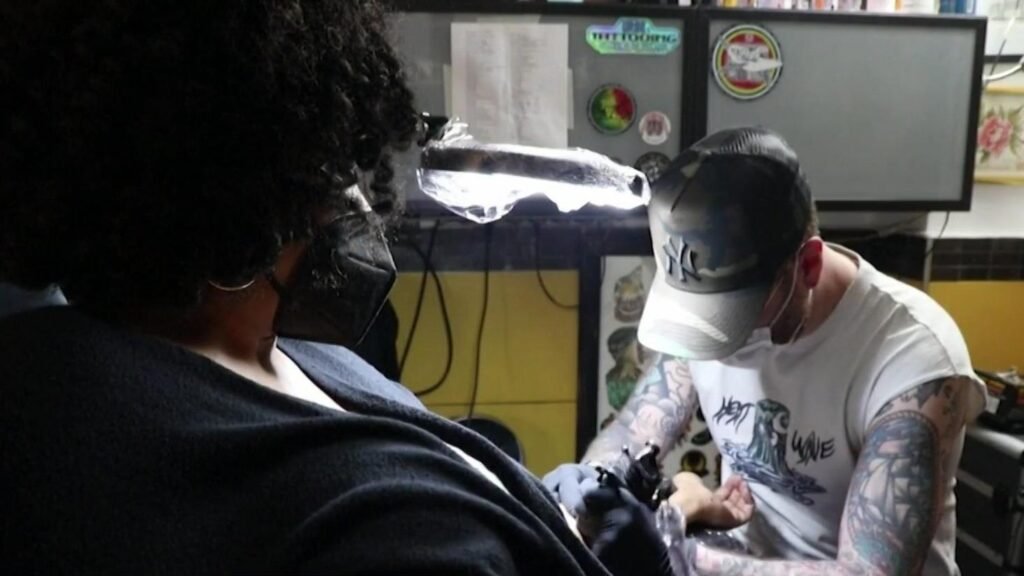John Sweek I am an assistant professor of chemistry at . Binghamton University, State University of New York.
A tattoo is incredibly common An enduring form of self-expression that dates back thousands of years. Since most tattoo artists follow strict health and hygiene regulations, you might think that tattoo ink would also be carefully regulated.
But as research conducted by my team of chemical researchers suggests, up to 90% of tattoo ink in the United States may be mislabeled. This is not just a case of missing pigments or slight differences. These inks contained potentially concerning additives that were not listed on the packaging.
What’s inside the ink?
All inks are made up of one or more pigments. Add color to your tattoo And some kind of carrier for that pigment. Before the 20th century, pigments used in tattoos included ash, charcoal, minerals, and other natural materials. However, around the mid-20th century, tattoo artists began making their own inks using synthetic pigments and dyes.
Currently, almost all pigments used in tattoos are made from synthetic molecules that can produce bright colors, with the exception of white and black pigments.
Over the past few decades, tattoo ink production has transitioned from being made by individual artists on their own to large corporations producing and selling ink to artists. My team wanted to know if these inks contained the ingredients advertised, so we analyzed 54 of his tattoo inks from the US market.
Ingredients not listed
More than half of the inks my research team analyzed contained unlisted polyethylene glycol, also known as PEG. His PEG is found in a variety of medical products, including laxatives. However, it can cause allergic reactions, and in the case of tattoos, research suggests that repeated exposure to PEG can cause kidney failure.
Propylene glycol was also detected in 15 types of ink, but it was not listed as an ingredient in any of the inks. Propylene glycol is generally non-toxic and is structurally similar to glycerin, which is used to thicken inks. Although propylene glycol is safe for most people, some people are highly allergic to it. In fact, it was named the American Contact Dermatitis Association’s 2018 Allergen of the Year.
An allergic reaction to propylene glycol can cause a skin rash, itching, and blisters.
My research team discovered an undescribed ingredient in some inks that is common in cosmetics but has not been tested in tattoo inks. These include BHT, dodecane, and 2-phenoxyethanol. At low concentrations, 2-phenoxyethanol can be a preservative. But the Food and Drug Administration warns that it can be transmitted to infants through breastfeeding, causing vomiting and dehydration in infants.
Of the 54 inks we analyzed, 29 reported the correct pigment, while the rest either did not report or reported the wrong pigment. This is a known issue with tattoo ink, but the ink manufacturer has not yet addressed it.
Concerns about dyes
Research shows that carbon black, the main black pigment used in tattoos, may be contaminated with some of the same carcinogenic molecules found in car exhaust and cigarette smoke. I already know.
Many red, yellow, and orange pigments are azo pigments, meaning they contain two nitrogen atoms bonded together. These pigments give the ink bright, vibrant colors, but over time they can break down into carcinogens.
European regulations prohibit the use of Pigment Blue 15 and Pigment Green 7, which contain copper, but in my research I found that they were the only blue and green pigments in the inks I tested. The EU has banned these dyes from use in hair dyes over concerns they could cause bladder cancer, but researchers have yet to study their link to tattoos.
A new focus on regulation
The FDA is starting to pay more attention to the ingredients contained in tattoo inks. In 2022, Congress passed the Modernization of Cosmetic Regulatory Affairs Act (MoCRA), giving the FDA more authority to regulate tattoo ink.
Although the FDA is still deciding how to implement MoCRA, the law would require accurate ingredient labeling and expand FDA’s authority to recall inks. Until now, tattoo ink has rarely been recalled due to bacterial contamination, and only on a voluntary basis.
So what does this mean for tattoo clients and artists? Currently, there is no clear research consensus on whether tattoos are safe or not, as they can cause infections and allergic reactions. Additionally, tattoos vary widely in size, color, and physical location on the body.
Research like the one conducted in my lab is an important part of figuring out what tattoos actually are, and allows researchers to better understand the harmful effects such as long-term allergic reactions that tattoos can cause. You will be able to understand it better.
Understanding what’s in the ink can also help doctors identify health problems in people with tattoos.
Tattoo-related health problems that researchers know are caused by unskilled artists who follow poor hygiene procedures. To prevent potential health concerns, those considering a tattoo can work with an experienced, trained artist who follows best practices for hygiene and tattoo aftercare.
This article is republished from conversation Under Creative Commons License.

